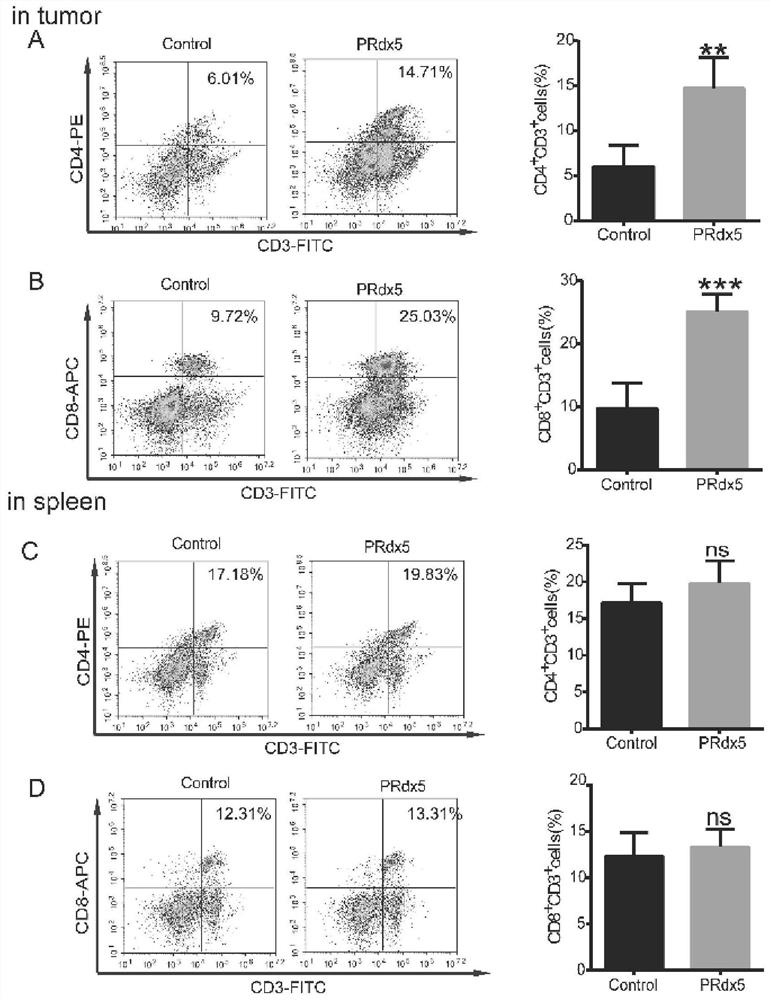A host factor hprdx5 with anti-tumor effect, its coding gene and its application
A factor and host technology, applied in anti-tumor drugs, applications, genetic engineering, etc., can solve the problems of poor repeatability, lengthy acquisition cycle, and low quality controllability.
- Summary
- Abstract
- Description
- Claims
- Application Information
AI Technical Summary
Problems solved by technology
Method used
Image
Examples
preparation example Construction
[0032] The invention provides a method for preparing the host factor hPRDX5, comprising the following steps:
[0033] 1) using the gene as a template, using the primer pair to perform PCR reaction amplification to obtain a DNA fragment with a double restriction site;
[0034] 2) Carrying out double digestion with EcoRI and HindIII respectively on the DNA fragment and the carrier with double restriction sites, and connecting the obtained DNA fragment and the carrier to obtain a recombinant vector;
[0035] 3) introducing the recombinant vector into a prokaryotic expression vector, culturing, inducing, separating and purifying to obtain the recombinantly expressed host factor hPRDX5.
[0036] In the present invention, the amplification system of the PCR reaction is preferably 2×PCR mix 10 μL, ddH 2 O 8 μL, 50-200 ng / μL DNA template 1 μL, 20 μmol / L forward primer 0.5 μL and 20 μmol / L reverse primer 0.5 μL.
[0037] In the present invention, the amplification program of the PCR ...
Embodiment 1
[0050] Amplification primers hPRDX5-forward primer and hPRDX5-reverse primer were designed according to hPRDX5 sequence. The DNA template used for the amplification is a codon-optimized DNA sequence (SEQ ID No. 2), and the PCR amplification is for introducing the required enzyme cutting site.
[0051] The primer sequences are as follows:
[0052] hPRDX5-forward primer: ggaattcatggctccgatcaaagttggtgacg (SEQ ID No. 3);
[0053] hPRDX5 - reverse primer cccaagcttttacagctgagagatgatgttcgga (SEQ ID No. 4).
[0054] The PCR amplification system is: 2×PCRmix 10μl, ddH 2 O 8 μl, template DNA 1 μl (about 50ng-200ng), 20 μM forward and reverse primers 0.5 μl each. The PCR reaction conditions were: 96°C, 2min pre-denaturation; 96°C, 1min denaturation, 56°C, 30s annealing, 72°C extension 40s (30 cycles); finally 72°C extension 5min, 4°C storage.
Embodiment 2
[0056] Construction method of recombinant plasmid expressing protein hPRDX5
[0057] After the PCR amplification in Example 1 is completed, first use 1% agarose gel for electrophoresis, and the voltage is 120 volts. After tapping the gel, use the gel recovery kit (Beijing Kangwei Century Biotechnology Co., Ltd.) to recover about 480bp. The DNA fragment was then digested with EcoRI and HindIII, and the obtained DNA fragment was ligated with the vector pET28a(+), and then the ligated product was transformed into Escherichia coli DH5a competent cells, in LB containing kanamycin antibiotic Screened on the plate.
[0058] Recombinants were verified by double digestion with restriction endonucleases EcoRI and HindIII. The digested products were subjected to agarose gel electrophoresis at a voltage of 120 volts, and the fragment sizes were verified to be about 480 bp fragments and about 5300 bp vectors.
PUM
 Login to View More
Login to View More Abstract
Description
Claims
Application Information
 Login to View More
Login to View More - R&D Engineer
- R&D Manager
- IP Professional
- Industry Leading Data Capabilities
- Powerful AI technology
- Patent DNA Extraction
Browse by: Latest US Patents, China's latest patents, Technical Efficacy Thesaurus, Application Domain, Technology Topic, Popular Technical Reports.
© 2024 PatSnap. All rights reserved.Legal|Privacy policy|Modern Slavery Act Transparency Statement|Sitemap|About US| Contact US: help@patsnap.com










